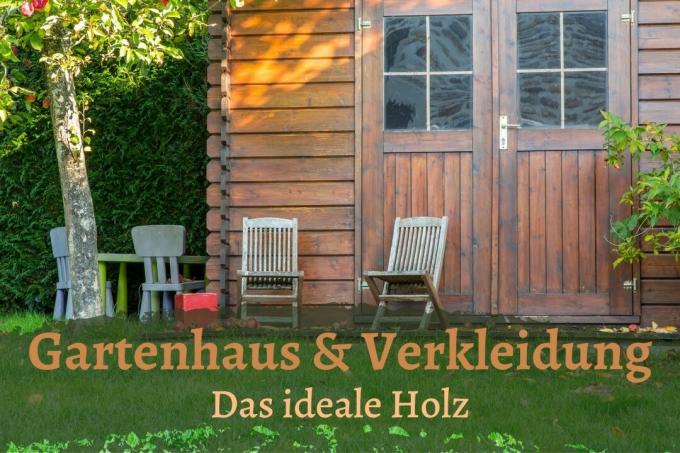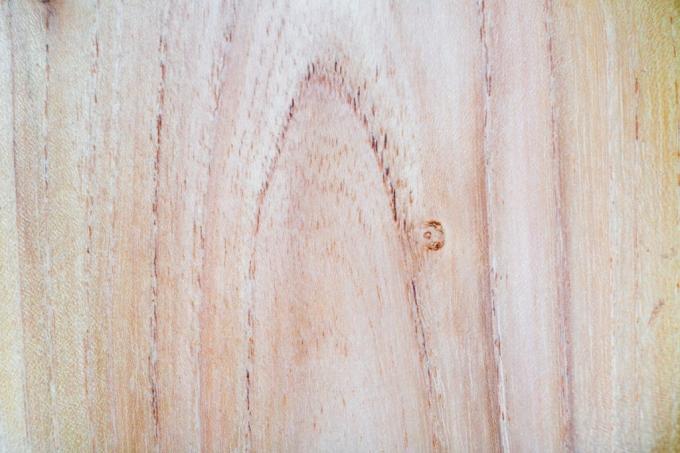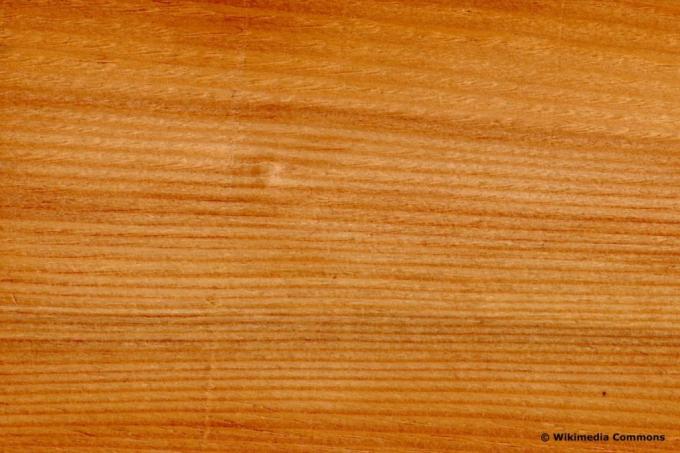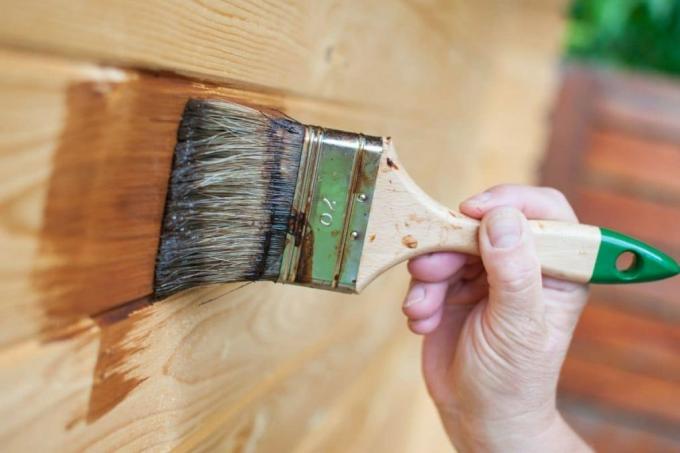
table of contents
- Necessary properties
- Pests & Diseases
- Structural wood protection
- Construction timber
- Types of wood for construction timber
- Wood cladding
- Pre-treated woods
- Other wood preservatives
- frequently asked Questions
A wooden garden shed has a natural charm that goes very well in any garden. The same goes for wood paneling. which Wood species is well suited for this, read here.
In a nutshell
- different woods have different properties
- Types of wood for outside must be weather-resistant
- Impregnated wood makes the job easier
- Wooden components need to be cared for
- regional woods are more environmentally friendly and the price is lower
Necessary properties
Garden houses are naturally exposed to the elements. These include rain, wind, ice and dirt, but also strong sunlight. The type of wood that is used for construction must be resistant to these weather conditions so that the wooden house will stand for a long time. Wood paneling, which is used to make an old garden shed look good again, for example, must also be weatherproof. There are two ways to achieve long shelf life. On the one hand, naturally resistant woods can be used and on the other hand pre-treated wooden components.

Pests & Diseases
Pests, especially various wood-dwelling beetles and their larvae, can destroy wood as well as various fungal diseases. Mushrooms like it moist, so you should go to the Construction of a garden house only use really dry wood. The residual moisture must not exceed 20 percent.
Note: Wooden components that are too damp can warp after installation, which is one reason why only dry wood is used.
Timbers dry through proper storage or are sold already dried. If the wood for the garden shed is freshly sawn, you should definitely store it in a dry place for a while before you use it. This is done by stacking it up so that enough air can circulate between each beam and board.
Structural wood protection
So that fungi and pests don't stand a chance, you need to use structural wood protection. This ensures that rain either does not reach the wooden parts or can run off easily without the wood becoming very moist. Contact with the ground can also increase wood moisture. Structural measures:
- Let the roof survive
- sloping wooden edges
- provide horizontal wooden surfaces with a slope
- If necessary, protect horizontal surfaces against rain with sheet metal
- Planting climbing plants can protect wooden walls from moisture penetration
Basically, you should protect all components that you have not treated with wood preservative or will not protect from the weather. You can achieve this with posts, for example, by inserting them into metal ground spikes so that they do not lie on the ground.

Construction timber
To the Construction timber includes all wooden components that you need for the basic construction of the garden shed, for example square timbers, posts and boards. The properties of the wood must be as follows:
- As dry as possible, so that there is little or no loss afterwards
- sustainable
- cut in such a way that minor cracking is to be expected
- mostly in defined sizes and shapes
Types of wood for construction timber
Spruce
- Description: Softwood, few knots, straight growth, very resinous and resinous odor
- Color: light-dark structured, darkens
- Resistance: little natural resistance to fungi or insects without treatment
- versatile wood, which is suitable for all building projects, often the lowest price
Note: Pressure impregnated spruce wood is most commonly used in horticulture.
larch
- Origin: as it is rare in Germany, Siberian larch is imported
- Description: hardest local softwood, slightly resinous odor, knots depending on the origin
- Color: reddish to reddish brown, darkens strongly, strongly grained
- Persistence: little to moderately, of course, permanent
Robinia (false acacia)
- Origin: comes from North America, cultivated in Germany and invasive
- Description: Hardwood, trees often grow crooked, the wood yield is low, knots, processing difficult
- Color: yellowish green to brown, darkens afterwards
- Resistance: very durable
- Use: particularly suitable for gardening and landscaping due to its natural resistance, but less available than conifers, price may be higher

Wood cladding
The wood cladding serves two purposes. On the one hand, it protects the construction timber from the weather and, on the other hand, it should give the garden house a decorative appearance. That is why different wood is sometimes used for this than for the basic construction of your garden house. It is also possible to use tropical woods for the wood cladding, which due to their natural properties are usually better protected against the weather than native woods. Local wood species should always be provided with wood preservatives if they are to be used as wood cladding. Tropical woods are usually much more expensive than domestic woods, but they also have a more elegant appearance.
Note: Wood cladding with tongue and groove is particularly easy to attach and offers many advantages. Another possibility is to attach horizontal boards like scales.
Native wood species
Douglas fir
- Origin: North America, cultivated in Germany
- Description: Softwood, decorative, native woods mostly knot-rich, pleasant-aromatic odor
- Color: yellow-brown to reddish-brown, changes within the annual rings
- Persistence: little to moderately, of course, permanent
jaw
- Description: Softwood, straight grain, resinous and with a strong resinous odor
- Color: light to yellowish, rich in contrast, heartwood reddish brown, darkens
- Persistence: little to moderately, of course, permanent
fir
- Description: straight growth, few knots, little resin
- Color: yellowish white to reddish, with a purple-gray tint
- Persistence: little to moderately, of course, permanent

Not native wood species
Bangkirai
- Origin: comes from Southeast Asia
- Description: high density, hard, heavy type of wood, tends to form cracks, odorless
- Color: fresh yellowish, darkens to olive brown
- Resistance: very weather-resistant
teak
- Origin: comes from Southeast Asia, West Africa or South America, often cultivated today
- Description: very high-quality type of wood, greasy surface, wood from younger trees of lower quality, slightly rancid odor
- Color: light to darker brown, with darker stripes
- Resistance: very durable if the quality is good, often also used for garden furniture
Pre-treated woods
Thermowood
Thanks to a special heat treatment, thermally treated wood is resistant to moisture, making it perfect for a garden shed. This means that even types of wood that are otherwise not suitable for outdoor use are weather-resistant. These include, for example, beech and ash. Thermowood is suitable for floors or wood paneling, but not for load-bearing components, as the strength of the wood suffers during treatment. The heat treatment also ensures that certain components of the wood change in such a way that fungi and insects are deprived of their livelihood.
Due to the thermal treatment, hardwoods are better suited for outdoor use than coniferous woods, the strength of which is more impaired. Every type of wood darkens during treatment, but can be lightened again by UV radiation.
Pressure impregnated woods
In the boiler pressure process, wood is impregnated with chemical wood preservatives under pressure. The pressure ensures that the agent can penetrate deep into the wood. So it's not just superficially protected. The protection is permanent and extends the life of the wood in your garden house.
Other wood preservatives
These include oils, paints and varnishes. While oils penetrate deep into wood and offer good protection against moisture, paints and varnishes can also prevent the penetration of fungi. A distinction is made between film-forming wood preservatives and agents with biocides that are used in the commercial sector. If you buy chemically treated wood for the garden shed, then you should let it air out in the open for some time. In the interests of the environment, you should only buy wood that has been treated with biologically compatible agents.

frequently asked Questions
This includes domestic, untreated woods of spruce, larch or pine. With tropical woods, not only the origin is a problem, but also the long transport. Treated woods may have been treated with chemicals that are not environmentally friendly.
The regional sawmill is a good contact for all types of wooden components. It is worthwhile to get an offer for the required amount of lumber from several suppliers and then to choose the best price and the best quality. In addition to the usual types of wood, many sawmills offer other types on request.
Treated woods usually only need a refreshing care. Untreated wood must be treated with a wood preservative. After that, an annual maintenance with fresh paint, glaze or oil is sufficient, it also depends on the type of wood.



